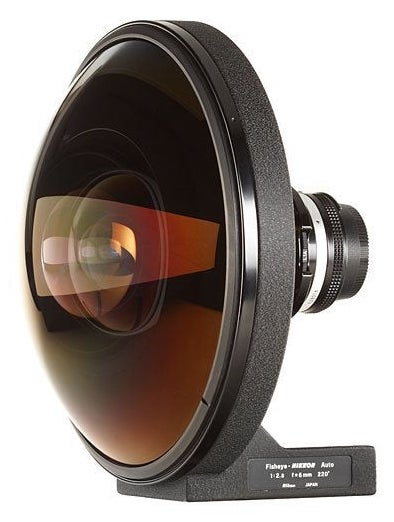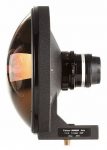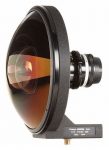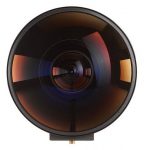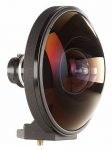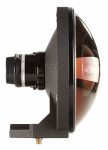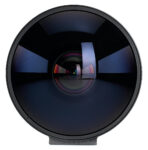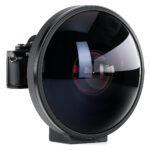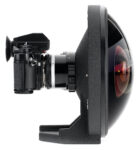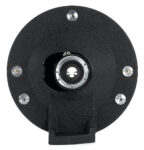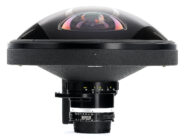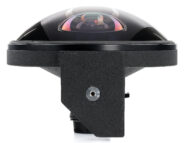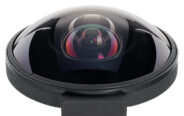Nikon AI Fisheye-Nikkor 6mm F/2.8
Fisheye lens • Film era • Discontinued • Collectible
- Announced:
- · 1977
- Production type:
- · Small-batch production
- Availability:
- ● Sold out
- Country of design:
- · Japan
- Original name:
- · Nikon Fisheye-NIKKOR Auto 1:2.8 f=6mm
- Class:
- · Fast full-frame circular fisheye lens
- · Professional model (Top class)
- System:
- · Nikon F (1959)
Abbreviations
| AI | A manual focus lens with automatic maximum aperture indexing, which is a mechanical system for coupling the lens to the camera's exposure system. Learn more |
| FISHEYE | An ultra-wide angle lens with strong uncorrected barrel distortion and extreme angle of view. |
Model history (3)
| ■Nikon Fisheye-Nikkor Auto 6mm F/2.8 | A | 12 - 9 | 0.25m | -- | 1970 ● | |
| ■Nikon AI Fisheye-Nikkor 6mm F/2.8 | A | 12 - 9 | 0.25m | -- | 1977 ● | |
| ■Nikon AI-S Fisheye-Nikkor 6mm F/2.8 | A | 12 - 9 | 0.25m | -- | 1982 ● | |
Specification
| Optical design: | |
| 35mm full frame | |
| 6mm | |
| F/2.8 | |
| 12 elements in 9 groups | |
| Circular fisheye | |
| Nikon F [46.5mm] | |
| 220° | |
| Diaphragm mechanism: | |
Diaphragm type: | Automatic |
Aperture control: | Aperture ring (Manual settings only) |
| 7 (seven) | |
| Focusing: | |
| 0.25m | |
| <No data> | |
Focusing modes: | Manual focus only |
Manual focus control: | Focusing ring |
| Physical characteristics: | |
| 5200g | |
| ⌀236×159mm | |
| Accessories: | |
| Removable front filters are not accepted | |
| Built-in L1A, Y48, Y52, O56, R60 (part of the lens optical system) | |
| Not available | |
| Nikon Teleconverter TC-14 → 8.4mm F/3.9 | |
| Nikon Teleconverter TC-14A → 8.4mm F/3.9 | |
| Nikon Teleconverter TC-200 → 12mm F/5.6 | |
| Nikon Teleconverter TC-201 → 12mm F/5.6 |
Sources of data
- Manufacturer's technical data.
- Nikon Sales Manual (July 1977).
- Nikkor lenses sales manual (January 1979).
- Nikon Sales Manual (June 1978).
Manufacturer description #1
The 6mm Fisheye-Nikkors are designed according to the equidistant projection formula like the 8mm f/2.8 Fisheye-Nikkor, but because of their wider picture angle they offer a more dramatic impact. These lenses were originally developed for special scientific and industrial applications in which wider-than-180° coverage is required such as surveillance work, photographing the interiors of pipes, boilers, conduits, cylinder bores and other constricted areas. And in advertising and commercial photography they are used extensively for dramatic effects.
The 6mm f/2.8 Fisheye-Nikkor has an automatic diaphragm, permitting thru-the-Iens viewing and focusing, and is meter-coupled for TTL exposure control with all Nikon and Nikkormat models so designed. Its relatively fast f/2.8 speed is a valuable aid in photography under dim lighting conditions, or where faster shutter speeds are imperative. It contains 5 built-in filters.
Manufacturer description #2
With an astounding 220° circular coverage, the 6mm f2.8 Fisheye-Nikkor can actually "see" behind itself. The lens focuses as close as 9.8 in., but thanks to its extreme depth-of-field, even nearer subjects will be rendered sharp when the lens is stopped down. A lens stand/tripod mounting socket is built-in, as is a 5-filter turret with skylight, two yellow, orange and red filters. This lens is available by special order.
Manufacturer description #3
Sales Points
- Circular fisheye coverage of 220 degrees
- Large maximum aperture.
- Through-the-lens viewing and focusing down to one foot (0.25m).
- Built-in lens stand/tripod mounting socket.
- Supplied with a set of 5 filters (skylight, two yellow, orange and red) built into a revolving turret, and slip-on front lens cap.
- Photographic uses include scientific and industrial applications, and special effects in advertising and commercial work.
Typical characteristics of fisheye lenses
- Extreme angle of view (at least 180° diagonally);
- Circular types (the image circle of the lens is inscribed in the image frame) or diagonal types (cover the entire image frame);
- Usually of equidistant projection type, with the distance from the picture center to any given point always proportional to the angle from the optical axis to that point;
- Huge barrel distortion;
- Short closest focusing distance (0.20 - 0.30m with 35mm full-frame prime lenses);
- Very large depth of field, eliminating the need for autofocus or precise manual focusing;
- Due to the extreme angle of view and convex front element, front filters cannot be used;
- Often equipped with a filter turret with swivel-mounted filters;
- Often come with a small, built-in petal-shaped lens hood.
Notes
- This AI lens was designed for Nikon F3, EL2, EM, FE, FE2, FE10, FG-20, FM, FM2, FM10, FM3A, Nikkormat FT3 AI cameras and Nikon FA, FG, N2000, N6000 AI-S cameras.
- AI and AI-S lenses are backward compatible with Nikon F, F2, Nikkormat FS, FT, FT2, FTN, EL, ELW cameras.
- On Nikon digital SLR cameras, the automatic exposure metering with AI and AI-S lenses will not be available on D40, D40X, D60, D70, D70s, D80, D3000-D3500, D5000-D5600 series.
Other fisheye lenses in the Nikon F system
| ■Nikon F mount (14) | |||||||||
| Nippon Kogaku / Nikon Fisheye-Nikkor 6mm F/5.6 | M | 9 - 6 | -- | 1970 ● | |||||
| Nikon Fisheye-Nikkor Auto 6mm F/2.8 | A | 12 - 9 | 0.25m | -- | 1970 ● | ||||
| Nikon AI-S Fisheye-Nikkor 6mm F/2.8 | A | 12 - 9 | 0.25m | -- | 1982 ● | ||||
| Nippon Kogaku Fisheye-Nikkor 7.5mm F/5.6 | M | 9 - 6 | -- | 1966 ● | |||||
| Nippon Kogaku Fisheye-Nikkor 8mm F/8 | M | 9 - 5 | -- | 1962 ● | |||||
| Nippon Kogaku / Nikon Fisheye-Nikkor Auto 8mm F/2.8 | A | 10 - 8 | 0.30m | -- | 1970 ● | ||||
| Nikon AI Fisheye-Nikkor 8mm F/2.8 | A | 10 - 8 | 0.30m | -- | 1977 ● | ||||
| Nikon AI-S Fisheye-Nikkor 8mm F/2.8 | A | 10 - 8 | 0.30m | -- | 1981 ● | ||||
| Nippon Kogaku / Nikon OP-Fisheye-Nikkor 10mm F/5.6 | M | 9 - 6 | -- | 1968 ● | |||||
| Nikon Fisheye-Nikkor Auto 16mm F/3.5 | A | 8 - 5 | 0.30m | -- | 1973 ● | ||||
| Nikon Fisheye-Nikkor 16mm F/3.5 | A | 8 - 5 | 0.30m | -- | 1975 ● | ||||
| Nikon AI Fisheye-Nikkor 16mm F/3.5 | A | 8 - 5 | 0.30m | -- | 1977 ● | ||||
| Nikon AI Fisheye-Nikkor 16mm F/2.8 | A | 8 - 5 | 0.30m | -- | 1979 ● | ||||
| Nikon AI-S Fisheye-Nikkor 16mm F/2.8 | A | 8 - 5 | 0.30m | -- | 1981 ● | ||||
Lenses with similar focal length
| ■Nikon F mount (4) · APS-C | |||||||||
| 7Artisans 7.5mm F/3.5 Fisheye | M | 11 - 8 | 0.29m | -- | 2023 ● | ||||
| Lensbaby 5.8mm F/3.5 Fisheye SLR | M | 8 - 5 | -- | 2014 ● | |||||
| Sunex 5.6mm F/5.6 Super Fisheye | -- | ? - ? | 1.00m | -- | 2007 ● | ||||
| Kelda 6.5mm F/3.5 Aspherical Fisheye CS | M | 10 - 7 | 0.30m | -- | ● | ||||
| ■Interchangeable mount (1) | |||||||||
| Spiratone 7mm F/5.6 Fisheye [T] akaHanimex 7mm F/5.6 Fish-eye | P | ? - ? | -- | ● | |||||
